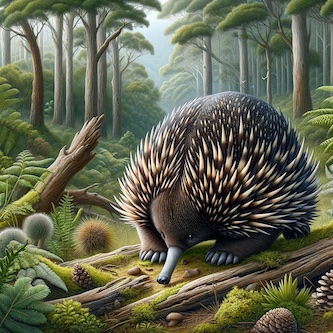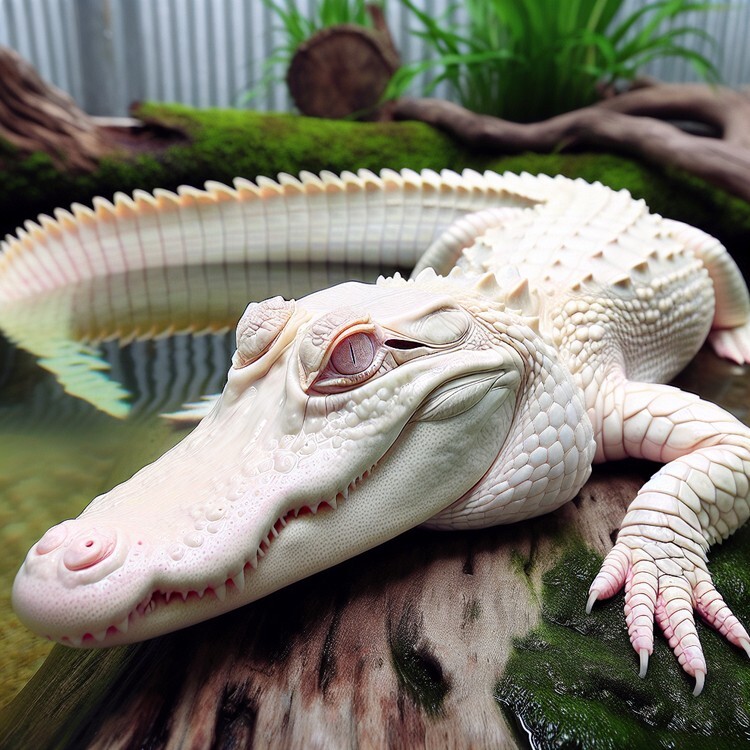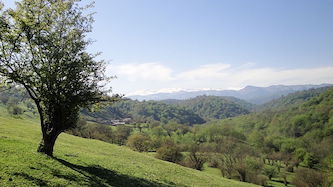A team of researchers from Oxford University went on an expedition in Indonesia and captured the first-ever footage of the Attenborough’s long-beaked echidna. This discovery is important because people thought this species was extinct. The echidna is an ancient mammal that lays eggs and is named after Sir David Attenborough. The team also found new types of insects and frogs, as well as healthy populations of tree kangaroos and birds of paradise during their month-long expedition in the Cyclops Mountains.
The Attenborough echidna and the western echidna are in danger of disappearing, and previous expeditions had found signs of their existence in the Cyclops Mountains. But it was hard to get to the most remote parts of the mountains to prove that they were there. Finding the echidna and other new species in the area shows that we need to work on protecting the Cyclops Mountains because it’s not currently a protected area even though it has a lot of different kinds of plants and animals.
The Cyclops Mountains are really tough to explore because they have steep cliffs, dangerous animals, and lots of earthquakes. But the scientists were able to confirm that there are dozens of new insect species and they found a new type of shrimp that lives in trees and a cave system that no one knew about. The team worked with local villages and respected their traditions and hopes that finding the echidna will help make the case for protecting the area.
The Attenborough echidna has been part of resolving conflicts between people in the area, and the discovery of this species and other new things shows why it’s so important to protect the Cyclops Mountains and all the different kinds of plants and animals that live there. The team believes that the Attenborough long-beaked echidna is a symbol of why we need to protect and take care of the region to make sure we can keep finding and saving its diverse wildlife.
Original news source: First-ever images prove ‘lost echidna’ not extinct (BBC)
Listen
Slow
Normal
Fast
Group or Classroom Activities
Warm-up Activities:
– News Summary
Instructions: Students will work individually to summarize the article in their own words, focusing on the main points: the discovery of the Attenborough’s long-beaked echidna, the importance of the Cyclops Mountains’ biodiversity, and the need for conservation efforts. They will then share their summaries with a partner, who will provide feedback on clarity and completeness.
– Sketch It
Instructions: In pairs, one student will describe a scene or aspect from the article (e.g., the Attenborough’s long-beaked echidna, the Cyclops Mountains, the new species discovered) without naming it, while their partner tries to sketch it based on the given description. Afterwards, they discuss the challenges and compare the sketches with images from the Internet or the article if available.
– Keyword Taboo
Instructions: Students will play a game where they must describe the article’s content to their partner without using a list of keywords (e.g., echidna, extinct, Indonesia, Cyclops Mountains, biodiversity). This will encourage them to use synonyms and explain concepts in different ways, which can expand their vocabulary and speaking skills.
– Opinion Spectrum
Instructions: The class will form a line or spectrum based on their opinions about a statement related to the article. For example, “It is crucial to prioritize the conservation of the Cyclops Mountains over other natural areas.” Students will then discuss their position with those nearby and the class will engage in a group discussion, allowing students to express and justify their opinions, and to practice persuasive language.
– Future Predictions
Instructions: Students will write down their own predictions about the future of the Attenborough’s long-beaked echidna and the Cyclops Mountains, based on the information from the article. They will then form small groups to share and discuss their predictions, practicing future tense structures and discussing environmental issues.
Comprehension Questions:
1. What did the team of researchers from Oxford University discover in Indonesia?
2. Who is the Attenborough long-beaked echidna named after?
3. What other types of wildlife did the researchers find during their expedition in the Cyclops Mountains?
4. Why is the discovery of the Attenborough echidna particularly significant?
5. What challenges did the researchers face while exploring the Cyclops Mountains?
6. What are some of the new species the scientists discovered in the Cyclops Mountains?
7. How did the research team show respect for the local villages during their expedition?
8. What role does the Attenborough echidna play in the local community and why is it important for conservation efforts?
Go to answers ⇩
Listen and Fill in the Gaps:
A team of researchers from Oxford University went on an expedition in Indonesia and captured the first-ever footage of the Attenborough’s long-beaked echidna. This (1)______ is important because people thought this species was extinct. The echidna is an ancient (2)______ that lays eggs and is (3)______ after Sir David Attenborough. The team also found new types of insects and frogs, as well as healthy populations of tree kangaroos and (4)______ of paradise during their month-long expedition in the (5)______ (6)______.
The Attenborough echidna and the western echidna are in danger of disappearing, and previous expeditions had (7)______ signs of their existence in the Cyclops Mountains. But it was hard to get to the most remote parts of the mountains to prove that they were there. Finding the echidna and other new species in the area shows that we need to work on (8)______ the Cyclops Mountains because it’s not currently a protected area even though it has a lot of different kinds of (9)______ and animals.
The Cyclops Mountains are really tough to (10)______ because they have (11)______ cliffs, dangerous animals, and lots of earthquakes. But the scientists were able to confirm that there are dozens of new insect species and they found a new type of shrimp that lives in trees and a cave system that no one knew about. The team (12)______ with local villages and respected their traditions and hopes that finding the echidna will help make the case for protecting the area.
The Attenborough echidna has been part of resolving conflicts between people in the area, and the discovery of this species and other new things shows why it’s so important to (13)______ the Cyclops Mountains and all the (14)______ kinds of plants and animals that live there. The team believes that the Attenborough long-beaked echidna is a (15)______ of why we need to protect and take care of the (16)______ to make sure we can keep finding and saving its diverse wildlife.
Go to answers ⇩
Discussion Questions:
Students can ask a partner these questions, or discuss them as a group.
1. What is an animal you thought was extinct but later found out it’s still around? How did you feel when you learned it was still alive?
2. How would you feel if you discovered a new animal species? Would you be excited or scared, and why?
3. Do you think it’s important to protect areas like the Cyclops Mountains? Why or why not?
4. Have you ever been on a hike or an expedition? What was the coolest thing you found or saw?
5. What’s the most dangerous animal in your country? Are you afraid of it?
6. Do you like watching documentaries about animals and nature? Why or why not?
7. How do you think scientists should work with local communities when they explore new areas?
8. Do you think new species are still being discovered where you live? Why do you think that?
9. Have you ever heard of tree kangaroos or birds of paradise? What do you imagine they look like?
10. Do you believe that every species, even the small insects, are important? Why or why not?
11. What is your favorite animal and why?
12. Do you think animals like the echidna should be named after famous people? Would you like to have an animal named after you?
13. Have you ever seen a cave or explored one? What was it like?
14. Do you think areas with lots of earthquakes should be avoided or explored more carefully?
15. If you could join a team of researchers on an expedition, would you want to go? What kind of adventure would you be hoping for?
Individual Activities
Vocabulary Meanings:
Match each word to its meaning.
Words:
1. captured
2. extinct
3. ancient
4. populations
5. disappearing
6. remote
7. tough
8. diverse
Meanings:
(a) Far away
(b) Having a variety of different things
(c) Caught
(d) Groups of living things in an area
(e) Gradually vanishing
(f) No longer existing
(g) Difficult
(h) Very old
Go to answers ⇩
Multiple Choice Questions:
1. What did the researchers from Oxford University capture the first-ever footage of in Indonesia?
(a) Komodo dragon
(b) Orangutan
(c) Sumatran tiger
(d) Attenborough’s long-beaked echidna
2. Why is the discovery of the Attenborough echidna important?
(a) People thought this species was extinct
(b) It’s the biggest echidna ever found
(c) It’s the only mammal that lays eggs
(d) It’s named after a famous scientist
3. Where did the researchers find the Attenborough echidna?
(a) Andes Mountains
(b) Rocky Mountains
(c) Cyclops Mountains
(d) Himalayas
4. Why is it difficult to explore the Cyclops Mountains?
(a) Extreme cold weather
(b) Steep cliffs, dangerous animals, and earthquakes
(c) Lack of food and water
(d) Thick jungle and swamps
5. What did the team find in the Cyclops Mountains besides the Attenborough echidna?
(a) Healthy populations of tree kangaroos and birds of paradise
(b) New types of insects and frogs
(c) Both a and b
(d) None of the above
6. What did the team work with local villages to do?
(a) Find new species
(b) Hunt for treasure
(c) Build a new road
(d) Respect their traditions
7. Why does the team believe the Attenborough echidna is a symbol of why the Cyclops Mountains should be protected?
(a) It has been part of resolving conflicts between people in the area
(b) It’s the only echidna in the region
(c) It’s the biggest echidna ever found
(d) It’s the most colorful echidna ever found
8. What does the team hope to achieve by finding the Attenborough echidna?
(a) Sell the footage to a TV show
(b) Start a new tourist attraction
(c) Make the case for protecting the area
(d) None of the above
Go to answers ⇩
True or False Questions:
1. The echidna is a common mammal that gives birth to live young and is named after Sir David Attenborough.
2. The Attenborough echidna and the western echidna are not at risk of disappearing, and the Cyclops Mountains are currently a protected area.
3. The discovery of the Attenborough echidna has further exacerbated conflicts between people in the area and downplays the importance of protecting the Cyclops Mountains and its diverse wildlife.
4. The team also did not discover any new types of insects and frogs, as well as declining populations of tree kangaroos and birds of paradise during their expedition in the Cyclops Mountains.
5. The mountains are difficult to explore due to steep cliffs, dangerous animals, and earthquakes, but the team found dozens of new insect species and a new type of tree-dwelling shrimp.
6. The team worked with local villages and respected their traditions, hoping that finding the echidna will help make the case for protecting the area.
7. A team of researchers from Oxford University found the first-ever footage of the Attenborough’s long-beaked echidna in Indonesia.
8. The team believes that the Attenborough long-beaked echidna is a symbol of why it’s crucial to protect and care for the region to preserve its diverse wildlife.
Go to answers ⇩
Write a Summary:
Write a summary of this news article in two sentences.
Check your writing now with the best free AI for English writing!
Writing Questions:
Answer the following questions. Write as much as you can for each answer.
Check your answers with our free English writing assistant!
1. What did the researchers from Oxford University find in Indonesia that was previously thought to be extinct?
2. Why is the discovery of the Attenborough’s long-beaked echidna significant?
3. What challenges did the scientists face while exploring the Cyclops Mountains?
4. Besides the echidna, what other new species did the team discover during their expedition?
5. How might the discovery of the Attenborough echidna contribute to the protection of the Cyclops Mountains?
Answers
Comprehension Question Answers:
1. What did the team of researchers from Oxford University discover in Indonesia?
The researchers captured the first-ever footage of the Attenborough’s long-beaked echidna, a species that was thought to be extinct.
2. Who is the Attenborough long-beaked echidna named after?
It is named after Sir David Attenborough, a famous broadcaster and natural historian.
3. What other types of wildlife did the researchers find during their expedition in the Cyclops Mountains?
They found new types of insects and frogs, as well as healthy populations of tree kangaroos and birds of paradise.
4. Why is the discovery of the Attenborough echidna particularly significant?
The discovery is significant because it proves the species is not extinct and highlights the need to protect the Cyclops Mountains, which is home to a diverse range of species.
5. What challenges did the researchers face while exploring the Cyclops Mountains?
The researchers faced steep cliffs, dangerous animals, and frequent earthquakes, making the exploration of the Cyclops Mountains very difficult.
6. What are some of the new species the scientists discovered in the Cyclops Mountains?
The scientists discovered dozens of new insect species, a new type of shrimp that lives in trees, and a previously unknown cave system.
7. How did the research team show respect for the local villages during their expedition?
The team worked with local villages, respected their traditions, and involved them in their research to maintain good relations and support.
8. What role does the Attenborough echidna play in the local community and why is it important for conservation efforts?
The Attenborough echidna has been part of resolving local conflicts, and its discovery underscores the importance of protecting the Cyclops Mountains and its diverse wildlife for future discoveries and conservation.
Go back to questions ⇧
Listen and Fill in the Gaps Answers:
(1) discovery
(2) mammal
(3) named
(4) birds
(5) Cyclops
(6) Mountains
(7) found
(8) protecting
(9) plants
(10) explore
(11) steep
(12) worked
(13) protect
(14) different
(15) symbol
(16) region
Go back to questions ⇧
Vocabulary Meanings Answers:
1. captured
Answer: (c) Caught
2. extinct
Answer: (f) No longer existing
3. ancient
Answer: (h) Very old
4. populations
Answer: (d) Groups of living things in an area
5. disappearing
Answer: (e) Gradually vanishing
6. remote
Answer: (a) Far away
7. tough
Answer: (g) Difficult
8. diverse
Answer: (b) Having a variety of different things
Go back to questions ⇧
Multiple Choice Answers:
1. What did the researchers from Oxford University capture the first-ever footage of in Indonesia?
Answer: (d) Attenborough’s long-beaked echidna
2. Why is the discovery of the Attenborough echidna important?
Answer: (a) People thought this species was extinct
3. Where did the researchers find the Attenborough echidna?
Answer: (c) Cyclops Mountains
4. Why is it difficult to explore the Cyclops Mountains?
Answer: (b) Steep cliffs, dangerous animals, and earthquakes
5. What did the team find in the Cyclops Mountains besides the Attenborough echidna?
Answer: (b) New types of insects and frogs
6. What did the team work with local villages to do?
Answer: (d) Respect their traditions
7. Why does the team believe the Attenborough echidna is a symbol of why the Cyclops Mountains should be protected?
Answer: (a) It has been part of resolving conflicts between people in the area
8. What does the team hope to achieve by finding the Attenborough echidna?
Answer: (c) Make the case for protecting the area
Go back to questions ⇧
True or False Answers:
1. The echidna is a common mammal that gives birth to live young and is named after Sir David Attenborough. (Answer: False)
2. The Attenborough echidna and the western echidna are not at risk of disappearing, and the Cyclops Mountains are currently a protected area. (Answer: False)
3. The discovery of the Attenborough echidna has further exacerbated conflicts between people in the area and downplays the importance of protecting the Cyclops Mountains and its diverse wildlife. (Answer: False)
4. The team also did not discover any new types of insects and frogs, as well as declining populations of tree kangaroos and birds of paradise during their expedition in the Cyclops Mountains. (Answer: False)
5. The mountains are difficult to explore due to steep cliffs, dangerous animals, and earthquakes, but the team found dozens of new insect species and a new type of tree-dwelling shrimp. (Answer: True)
6. The team worked with local villages and respected their traditions, hoping that finding the echidna will help make the case for protecting the area. (Answer: True)
7. A team of researchers from Oxford University found the first-ever footage of the Attenborough’s long-beaked echidna in Indonesia. (Answer: True)
8. The team believes that the Attenborough long-beaked echidna is a symbol of why it’s crucial to protect and care for the region to preserve its diverse wildlife. (Answer: True)
Go back to questions ⇧













